Sydney
25 April 2005
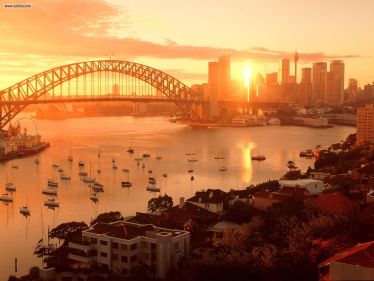
There are some other things I could talk about this morning, but I am going to let the smart people read the tea-leaves, as someone said yesterday. This remarkable situation will either sort itself out or it won’t. I prefer to contemplate times when things made sense in the great cities on the shores of the broad Pacific. We have talked about some of them lately.
My favorites include San Francisco on the American side, Hong Kong and Shanghai in the South China Sea, and sun-drenched Sydney on the Tasman Sea. These towns all have something in common, a certain raffish sophistication that is quite appealing. Sydney is something special, though.
It was ANZAC day in 1996 that I remember vividly, the second of three visits to confer with our Allies on matters of great import.
I have approached Australia from west and east, from the newer and older directions. The place being upside down, it was entirely right that my first visit was to the newer coast, at Perth, the second time to the landing beaches of the First Fleet at Sydney, and the third time for a month in the capital of Canberra where I actually saw it snow in the middle of the summer back up north.
I liked all three cities, though they have flavors as individual as their beers. Sydney is where the rag-tag band of adventurers and convicts ended their journey after Transportation, a universe away from the gray skies of Merry Olde. There on the desolate coast they began something entirely new.
The annual tri-lateral Australia-Canada-U.S. Intelligence Exchange was hosted by the Aussies the last time I was there. Due to some intentionally poor planning on my part, we could not connect with the once-per-week military flight that went Down Under. Consequently, we had to fly commercial air, but the conference was planned around the military schedule and we had to remain over the weekend at our hotel in the wild and wooly King’s Cross district of Sydney.
We established our own beach-head at the side-walk café in front of the steak house where the road bends to the left and begins the gentle decent to the harbor. We’d watch the women and drink the fine strong Australian beer for hours. The women were pretty, not that any of us were looking. We were too old for the frenzy I remembered from my first visit to Perth, twenty years before.
On that visit, the Royal Australian Navy hosted us that first night of the port visit, at a gymnasium. We were in whites and the beer was in kegs and long metal trays were placed on the floor to accept our cigarette-butts. And the women flowed in through the door, seemingly all wanting a Yank for the week. By the time we got downtown that night, I saw a guy from the sister fighter squadron ride by in the passenger’s seat of a shiny Rolls. The woman who was driving apparently had an appreciation for speed.
It was a grand time, far too busy to sleep, and predictably we met the loveliest woman in town about an hour before we had to leave Fleet Landing to return to the ship. She was a French-Vietnamese woman who combined the best of east and west, and spoke with a lilting Aussie accent. The crowd of officers gawking at her behind the bar was at least five deep.
The three visits encompass the arc of time from youth to age. It was enough on the trip to Sydney to visit to sit and watch the carnival of King’s Cross to sweep by, and marvel at it. At the time, I was still in the process of destroying the cartilage in my knees, and we would rise just before dawn to go jogging. King’s Cross is like San Francisco. We were just starting the day and the hookers and transvestites were headed home.
Regardless of the hour, Harry’s Café de Wheels down by the Naval base was always open. We ran down to get coffee. Even at that hour there was a crowd, munching those strange sausages on elongated buns, or the signature pies, filled with mashed green peas.
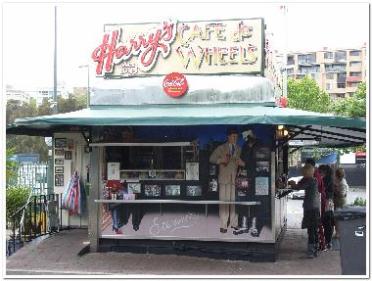
The trailer is an elongated building made of corrugated metal. There was a little awning that jutted out over the counter area, but otherwise the place was completely open to the elements. In the dark, even with the glow of the lights of the city, you could see the Southern Cross.
In keeping with the name, the diner appeared to have been mobile, at one point, but it had apparently put down roots and would never move again. They told us the tradition of mashed pea-pies with gravy served from trailers apparently goes back to the 1870s, and some purists sniff that the food at Harry’s is awful.
A framed picture of Frank Sinatra enjoying one of the pies hung on the wall under the overhang. I agree with Frank. Harry’s is a fine place to look at the water, and stretch the legs.
The diner is behind some warehouses, near the place where the First Fleet arrived. They could have used a visit to Harry’s. They had been at sea for eight months, and had 750 prisoners consigned to colonize a place called Botany Bay. Captain Arthur Phillip, Royal Navy, was in command of the riff-raff, who had been sentenced to establish the first European settlement on Australian soil.
It is considered a note of local distinction to be descended from the line of one of the first convicts, a sort of austral Mayflower cruise.
The waterfront at Sydney is something special. After a cup of coffee, we continued to jog along the waterfront. As guests of the RAN, we had access to the Naval base itself, could run past the piers with the sea-foam colored warships and the quaint Victorian buildings.
The architecture makes these former Royal Navy bases post cards from the old Empire, all built from the same blueprints, whether they are in Port Arthur or Bombay. With the light coming up, our pace slowed to a walk, and then to a wander.
From the Naval Base you can look both out to broad bay and to the narrows, where Mrs. Macquarie’s Chair was carved out of a rock ledge for Governor Lachlan Macquarie’s wife, Elizabeth. The Opera House sits in splendid architectural cacophony across a little bay behind it, and beyond that the coat-hanger shape of the Harbor Bridge looms behind it near The Rocks neighborhood.
That morning, I turned back to look up the bay, wondering if we had enough time to keep walking, or whether we had to pick up the pace. I noticed that above the path a little glass-and-steel pagoda had been placed on the rocks. It was an old object, as things go here, and I climbed up to examine what purpose it served.
Beneath the cloudy glass were letters carved into the rock, graffiti left by the sailors of the First Fleet, first white people to come here, two-hundred and fifty years before. According to the little plaque on the pagoda, the runes are initials of the sailors and the name of their ship. There has been no change in sailors, from the days of sail to steam. A bottle of rum and pocketknife can provide hours of constructive fun.
Later, showered and in uniform, we discussed many topics of mutual importance at the conference, regional security issues, and the looming impact of China to the north. The gently expressed frustration of allies trying to keep aging equipment compatible with the gear that we seemed to change every year or two.
On Sunday, a day with no social obligations, I spent a moment in the blinding sunshine at the ANZAC Memorial.
The Australia-New Zealand Army Corps is the touchstone of the two nations. You can say, fairly, I think, that they were colonies before the Corps was raised, and after the flower of their youth was savaged by the Turks under the cliffs of Gallipoli, they grew up.
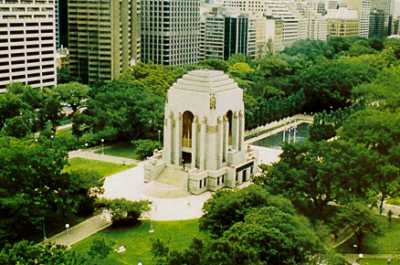
(Image from a photograph courtesy of ANZAC Memorial, Sydney).
It was traumatic, but the anger at the loss of life forged an identity that was completely independent from that of overseas British citizens. Inside, in the silence under the dome, a bronze statue of a nude young man is draped on a marble base. With bayonets, he lies prostrate, eyes looking up not in supplication, but resignation. Light floods his form.
This is the place the Aussies commemorate the losses at Gallipoli, far from the sheep stations and gold mines of the Outback, and the sandy beaches. Winston Churchill sent the diggers and Kiwis of the ANZAC Corps there to be slaughtered there in the “soft underbelly” of the Triple Entente in 1915. It is not fair to blame Winston for the execution. The idea was good enough, in its way. Regrettably, it was not enough to have an idea. There had to be logistics and planning, and there was little of that.
We had a whole block of study on the Gallipoli disaster at the War College, an exercise in understanding how badly something can go with poor planning. Our instructor was a retired Colonel of Marines who had walked the ground personally. He had a slide presentation that conveyed the horror of that battlefield, the attackers huddled at the base of the cliffs with the Turks shooting down on them. The soldiers- Diggers they called themselves- lived in dugouts to avoid the snipers. They could not avoid the dysentery and criminally bad leadership.
The Turks were brave, and their German advisors were crisply efficient at killing the members of the ANZAC Corps.
As a result, the Aussies and Kiwis have an attitude. They were still pissed at the Pommy bastards who sent them in eighty years later. For context, Australia on that day had only 12 million inhabitants. In 1915, there were considerably fewer. And what they gave up under those highlands was enormous in its per capita cost. Britain took the brunt of the casualties, over 120,000 of them, with 25,000 dead. But the number of the dead and wounded for the ANZAC was devastating for the colonies. Australian wounded amounted to 26,111, with 8,141 killed. Little New Zealand took 7,571 casualties, with 2,431 dead.
The campaign was deemed by the Pommy Bastards in Chief to have been lost by the onset of winter, and the troops were evacuated in December. To have lost so much, and gained nothing at all gave the observance of the anniversary of the campaign a semi-religious air, and one with a distinct pacifist connotation. All the young men dead and maimed, all lost for nothing.
In 1922, the government was forced to declare a public holiday as people clamored for time off to honor the ANZAC. All the Diggers are gone now, and the holiday is much more secular. But it still features the unique Digger hat as the symbol, side folded up for Aussies, flat for Kiwis.
In Sydney, ANZAC Day has become both a commemoration and a bacchanal, just as Independence Day has here. They remember, though, because it was on the beaches below the cliffs at Gallipoli that the colonies became nations.
Sydney is a grand town, in youth or age. I don’t know if I will ever be back, but it is a hell of a place.
Copyright 2014 Vic Socotra
www.VicSocotra.Com
Twitter: @jayare303
Rest and Recreation
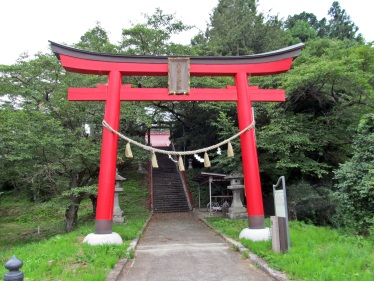
It was Tokyo, 1980. I was taking a break from the military coup in Korea about halfway through my 14 month one-year-tour on the Peninsula, not that I was counting.
The Generals had killed President Park the year before and Major General Chon Tu Hwan, pride of the Korean Military Academy’s Class 11, had taken off his uniform, traded in his three stars for a crisp civilian suit and set up shop in the Blue House in Seoul.
One of his first acts was to brutally put down a student insurrection in a town called Kwang-Ju. They still can’t agree on how many died there.
I needed to go someplace that did not have a lot of guns on the street. Some of the guys doing what I did would take a break in the middle of their tours. I figured I could do a year standing on my head. But after the massacre at Kwang-ju that is exactly what I felt like- inverted. I was having a hard time figuring out who the good guys were.
I caught a MILAIR flight out of the USAF base at Osan, south of Seoul. There was a charter bus that made the loop from Yongsan Garrison, and it literally was as easy as falling out of my rack in the hooch I shared with three Army Warrant Officers on South Post.
Yokota was a breeze, and the charter bus deal getting back to my old stomping ground south of Yokohama. At the Camp Zama Combined Club, I looked up Master Sergeant Jim-the-Spook Slowey, US Army.
I had met him the first time at the seedy Adam Bar at the old Hamilton Hotel in Seoul one afternoon in between shifts in the Command Alert Center. When you are working around the clock in phases you get used to drinking at odd hours, and this was a golden afternoon in late summer.
Jim was holding court to the thin crowd at the bar. He spun some tales in his clipped English voice, he did. I’m still not sure which level of him I understand even today.
As you know, the craft of Intelligence is largely about peeling back the layers of the onion. Each layer has a reality, related to but not necessarily true to the layer beneath. I have met people from all our Agencies and a good number from the other side. We all have our quirks, our manners, our blind spots.
Military intelligence is pretty straightforward. Even when the guys are being discreet they stick out. It is the haircut or the bad suit that gives them away.
They are the storm-crows of crisis. Company spooks, the ones from Langley, are credentialed as something else, and there is a sleek entitlement to them. You can feel it. The National Security Agency does our signals intelligence, grabbing things out of the air, and they tend to be a little anti-social, since they don’t have to talk to you to know what you are thinking.
National Reconnaissance Spooks are so secret that their agency didn’t actually exist. I think it is actually two air force lieutenants and the Lockheed-Martin Corporation. But they are doing you from space, not in your face, so why would you care?
The National Imagery and Mapping Agency is just looking at your picture, combing your hair, or drawing a map to your house. And all the rest of them, the Drug Spooks and the Justice Spooks and the commerce Spooks are the sideshow crowd. We Cold Warriors didn’t worry about them, unless we had branched out and got on the wrong side of a money investigation.
When I went on my rest and recreation trip I left at least six of our services behind. If you threw in the Allies, that was another five or six services collecting on each other and that doesn’t begin to talk about the bad guys. Part of the business in those days was recruiting sources. Which meant a lot of time sitting around in bars. Which is where I met Jim at the Adam Bar in the seedy Hamilton Hotel.
I think Jim was an operational Army Spook, or maybe that was just part of his legend. I looked him up at his home in Japan. Swap some lies- and in this case I couldn’t figure out even where they began, much less where they ended.
Here’s the dossier as I heard it. Back in 1980 he claimed he was 48, and he looked every day of it. He would wheel out whatever version of his life he chose to share was a ride on a roller-coaster. It started with a hitch in the British Army’s Coldstream Guards, and he claimed to service at Suez and in Kenya and Malaysia. Then on to join the UN Police Action in Korea, and then capture by the Chinese. Thence to a camp in south China in chains, he said quietly.
“Rum show, that,” said Jim in a clipped tone. “Then one day an NKVD Major showed up with the Chinese guards. The Senior Ranking Officer got us all together and told us we were for it unless we hit the wire that night. So 17 of us went for it and 4 got across.
“You did what?” I said.
“Walked out of China. We didn’t know until we woke up one morning in a rice paddy and saw rifles leveled at us. I looked at the weapons and didn’t know what to think. They were British .303s. We thought the Chinks had grabbed a group of our guns. That was the first time I heard Thai.”
“Let me get this straight,” I said slowly, taking a sip of a very creditable whiskey. “You had walked out of China and into Thailand?”
“Quite right. Surprised us, too. We thought we had crossed over into Laos someplace. We thought we forded the Mekong, but p’rhaps it had been the Kwai. Didn’t have anything in the way of maps, don’t you know.” He polished his glasses.
I was invited to his house at Camp Zama. His cover was Army Veterinary Corps, since they do all the food inspections all over the Far East. It was a good cover for counter intelligence, since he had access to every post station and ship that fed troops.
He told me he was a Colonel when I looked at the sign by the door that said “Master Sergeant.” We had been talking about Ireland, as well, since that was his surname came from. Over drinks he took a short wooden staff from the mantelpiece and handed it to me. It was the baton of a Marshall of the Third Reich. Jim said it belonged to Albert Kesselring.
He had been the commander of German forces in Italy during World War II, and his daughter was his wife. She appeared with more drinks. She had brown hair and blue eyes as brilliant as Jim’s. She told me a little about her father, his cheerful and intimate relations with the women of France between the wars. And of his efforts to save the great art of Italy during the savage campaign. I did not comment on Monte Casino, the great monastery on the hill from which he ran the aggressive defense against the Allied landing at Anzio.
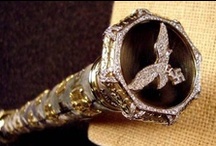
She seemed to think her father was a pretty good guy, and I realized that Jim did, too. I ran some of the story over in my mind. Captured by Chinese. Irish by birth- IRA? Married to a Nazi’s daughter. An officer masquerading as a senior enlisted guy. Or vice versa.
I live in the vice versa world. I turned the baton of a German Marshall over in my hands. It was crafted of rich ebony, festooned with gold and capped with eagles and the insignia of the Reich.
I have to say it was the Marshall’s daughter that finally spooked me. Her eyes were blue as a northern lake, and just as bottomless. Jim leaned over to me and suggested we go have some more drinks at a place the Japanese host service ran across town. I politely declined, thinking a honey trap was about the last thing I needed with our friends the Japanese, and with much protestation of undying friendship, I finally got a cab and went to the Naval Air Station at Atsugi.
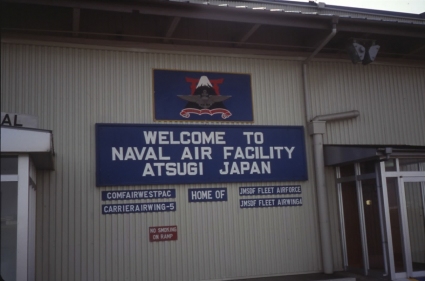
I never saw him again, which is both good and bad. Whatever he was, he had a hell of a story.
I heard, years later, that he had passed on but decided to stay in Asia. The interesting thing was where he chose to be buried: at the US-Philippine cemetery up near where Clark Air Base used to be. My pal Master Chief Bobby Hubbard is there, too, and I sometimes toy with the idea of going back for The Long TDY myself.
Aside from the Embassy, it is the only place permitted to fly the US Flag in the Republic. I guess they realize the citizens there are not going anywhere.
Copyright 2014 Vic Socotra
www.vicsocotra.com
Twitter: @jayare303
Seoul City

THE SNAKE RANCH
YONGSAN SOUTH POST
11 May 1980
It appears that the bad Koreans are all out planting mines (a good sign, from what they tell me) or transplanting rice. They couldn’t fly their MiGs due to inclement weather. The telephone circuits were down because the lines that run on the poles outside the Snack Bar caught fire.
It is good to know that they have put a lot of thought into what happens when the Free Rockets Over Ground (FROGS) start impacting outside the Class VI Liquor and Convenience Store.
After Japan, I have to tell you that Korea takes some getting used to. It is more than a little backwards, compared to Yokosuka and the sprawling Kanto Plain around Tokyo. The set-up here is surreal, the culmination of 26 sequential one-year tours since the Armistice was signed. Normal chain of command doesn’t exist.
Naturally, I am confounded by the military-political lash-up in which I have to live and work. I am on South Post of Yongsan Garrison, the big US Army base that is home to the 8th US Army and the UN Observation Post. There is a remarkable bar and shopping area next door called “Itaewan.” You can get just about anything there, much more like the P.I. than Japan. I have a story about the Hamilton Hotel I will share with you at some point.
As far as the military lash up is concerned, there are two separate and autonomous organizations control the Combined Field Army, and the ROK First Army. Theoretically there are liaison units built into the system, but it is a bit disconcerting to attempt to talk to the Yank team over at the First ROK Army (FROKA) and get the Gate Guard, who hasn’t the faintest idea where the duty officer is.
That is the command and control in the field. Once things start to narrow down towards the pointy end of the pyramid it gets really weird. There is a ROK counterpart to each U.S. Officer, all the way up to the Commander in Chief, who happens to be US Army General John Wickham. There are parallel Intel outfits to support each echelon of command; some combined and some U.S. only (for the obvious reasons).
They are lettered, naturally, for accuracy and clarity, and number by function. “1’s” are personnel, “2’s” are intelligence, “3’s” are operations, “4’s” are logistics, “5’s” are plans and policy and “6’s” are communications. I have heard that there are “7’s” and “8’s” but I have never seen them in the world.
I still have not got the G’s, (which means Army) J’s (Joint formations of multiple services), and C’s (Combined organizations with multiple nations) straightened out in my mind. Some are accountable to each other, some we can talk some things to, and others attempt to inveigle themselves into our confidence to gain perceived advantage, since knowledge is power and we have the strategic reconnaissance capabilities most of the world can only envy.
The ancillary support commands appear on the wiring diagrams like a plate of linguini.
Currently the fiasco in progress involves the ‘C’ side of the house. (I like that phrase a lot. That and the term U/I, or “unidentified,” are really all you need to communicate around here in rich detail).
“Well, sir, are monitoring some U/I activity in an un-located Corps conducting an unspecified evolution.”
Seriously, I have briefed items Just Like That to general officers, and one of the deputy CINCs just nodded and thanked me for the information. I have no idea what he thought he was going to do with it.
Anyway, the ROKs are hot to have their grubby little hands on an operation like ours, so they have sold the concept of combining everything into a giant unified organization.
It was nonsense, of course, but since President Carter was going to pull everything out anyway, our side went ahead with the program. Now we have a co-equal intelligence outfit half-staffed with ROKs who can barely speak English, and can’t be told anything important.
I have nightmares about attempting to run an all-source indications center with only a curtain between me and dozens of ROKs eager to access the coffee pot, or use the head. It is all a lumbering attempt at unemotional Nice Guy-ism, a policy that has worked marvels all over the world for us.
Thankfully I am just a cog in the machine. I don’t have to worry about things like getting promoted (they call it “frocking”) eight months early like the two female line officers, or the traditional end-of-tour Joint Service Commendation Medal which I will probably lose for the crime of buying more than one jar of Hellman’s mayonnaise in a single month.
I am not kidding- the above punitive action actually happened to some poor geek who toiled here for eight years.
The corruption and thievery has got to be seen to be believed. There was a pizza shortage at the Club because someone hi-jacked the truck bringing bulk cheese up from Pusan.
All the Navy guys here appear to have married Koreans. No big deal, not that I am inclined to do that.
But one of the great features of that is the aspect of family augmentation. The bride’s family moves in with the happy couple, and magically, the entire crew are now U.S. dependents, entitled to a fair shot at the Commissary, larger Government housing, and more sugar. That is all purely legal, so the black market end of things only starts at the far end of the abuse spectrum. Consequently the poor Army creeps have to come down hard and heavy on everyone.
You are guilty until proven innocent. I heard that the Korean personnel at the PX have a neat trick of adding on controlled items to receipts after the hapless customer has departed the store.
Three months later, “Now, LTJG Socotra, just why did you attempt to purchase 80 pounds of ground coffee two months ago?”
“Huh? What are you people talking about?”
I am happy I got a chance to see what happens when all the supplies are just laying around on dry land, waiting to be misappropriated and mal-feased. I have come to like the Navy more than I ever did.
At least the Navy actually attempted to get us our mail (did I mention the entire staff of the Army Post Office is under indictment here, and a blatantly illegal search team is stationed at the point of entry for all mail?)
I will be working the mid watch out of Military Bunko tonight, and must leave the Hamilton Hotel story for later. I may get to it tomorrow. I will tell you Seoul is one strange town, and I have not even mentioned the coup, or antics of Korean Military Academy Class #4. Or what they did in Kwang-ju to all those students.
That was an eye-opener, when the Commander of the special weapons dump down there called us up in the Command Bunker and said there were all kinds of people at the gate trying to get in. Interesting place.
Vic
Copyright 2014 Vic Socotra
www.vicsocotra.com
Twitter: @jayare303
Mass in B-Minor

Senior Executive Jerry and I stay in touch- he is still in the government, I am not, and it is fun catching up on the old colleagues who still labor in the madness. He is an avid reader and we compare book lists and new favorites when we get together at Willow.
He also shares his passion, which is his membership in the Washington Choral Arts Society. Passion and madness share a certain amount of common ground, and the chorus is a very active organization, particularly around the holidays.
They also are invited to a variety of overseas venues in the summer due to their reputation for excellence, but this is not a professional organization that pays a living wage. These are all volunteers, all of them with day jobs like Jerry, running Washington, working on the Hill and in the Agencies, and often racking up 60+ hour work-weeks to which they add rehearsals and performances when the rest of us are relaxing on holidays.
I always look for my pal on the televised version of A Capital Fourth- he is working while we drink and grill. This is about passion.
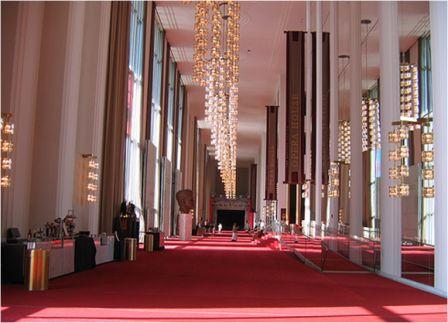
(The Atrium at the Kennedy Center).
Artistic Director Scott Tucker took over in 2012 from the venerable Norman Scribner, who founded the organization that is now in its 48th season. The Society has a budget over a million dollars a year and has sung with the world’s leading orchestras and conductors, while maintaining a special relationship with the National Symphony Orchestra. They have recorded seventeen CDs from material in its annual subscription series in the Kennedy Center Concert Hall. Special programs like their Annual Choral Tribute to Dr. Martin Luther King, Jr., have cemented a unique relationship between the society and their city.
I am not much for formal evening activities any more- I get up too early and my energy is not precisely the same as it was when I stormed the liberty ports of Asia years ago. That is why I look for the afternoon concerts to share a little of their culture, and this concert at four pm on a chilly, windy wildly bright November day was just the ticket.
And, the performance was going to be what arguably is the masterwork of the master composer and musician of his age, Johan Sebastian Bach. His Mass in B-Minor is a setting of the complete Latin Mass in an intricate 27 movements with solo and choral voices, lush strings, horns, tympani and organ.
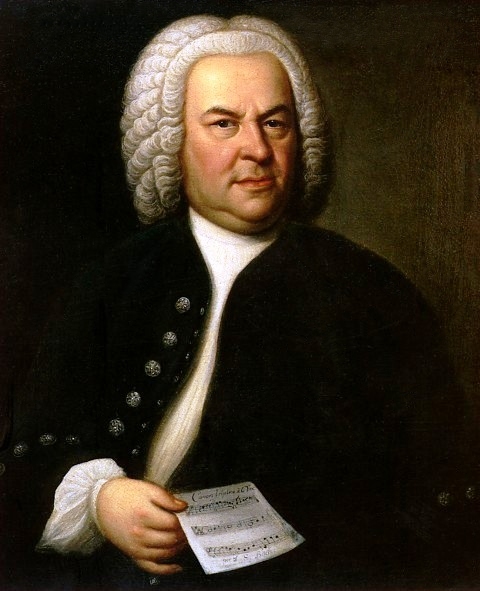
(J.S. Bach)
It was the culmination of the Master’s life work, and one of his last compositions when he was already blind. It was completed the year before his death in 1750. The Playbill informs us “the Mass gave new form to vocal music that Bach had composed throughout his career, dating back (in the case of the “Crucifxis” movement) to 1714, but extensively revised.”
Bach was a Lutheran, like the Pennsylvania Socotras, and it was unusual for composers working in that religious context to compose a complete mass- a missa tota. It is an oddity- in fact the whole thing was only performed in pieces never performed all at once until nearly a century after Bach was in his grave.
The judgment of history has been positive: the Mass has been described as one of the greatest compositions in musical history, which is going a ways. I am no connoisseur, though over the last decade or so I have found solace in listening to classical music on the local NPR outlet, and find that it soothes my soul after the abrasive discourse of the Imperial City.
Professor Markus Rathey at Yale sums up Bach’s motivation in creating a work he never saw performed in its entirety this way:
“The symmetry on earth mirrors the symmetric perfection of heaven. The purpose of art at this time—in architecture, the visual arts, and music—was not to create something entirely new, but to reflect this divine perfection, and in this way to praise God. We find such a symmetric outline in many pieces by Johann Sebastian Bach… but only in a few cases is this outline as consequent as in the B Minor Mass.”
And the Kennedy Center sells wine in the lobby before the performance. A glass before the performance began, nice seat in a parterre box at the back of the Orchestra Hall, and Jerry and his fellow volunteers gave us a chance to see what the sound of the soaring human spirit sounds like.
From the moment Scott Tucker raised his baton, the audience was captivated, enmeshed, enthralled. The voices soared in prayer, softened in reverence, roared in affirmation and rolled over us all in a wave in two hour-long parts, with a twenty-minute intermission.
My God, I thought. There is so much in this world that has twisted the passion of the human spirit into something awful.
Bach- through his instrument of the Choral Arts- reached out from beyond life to affirm the sanctity of ours, and the power of the spirit against time and place.
The voices were mesmerizing, the Choral Arts magic palpable. By the time we reached the dramatic soaring conclusion, I realized that the Mass in B-Minor is not the consecration of a master composures life work- it is the synthesis of every stylistic and technical contribution of his age.
I am not a particularly religious fellow- I distrust true believers of all stripes by hard experience- but I was reminded of the lines in Marc Cohn’s song “Walking in Memphis.
“Now Muriel plays piano
Every Friday at the Hollywood
And they brought me down to see her
And they asked me if I would
Do a little number
And I sang with all my might
And she said
“Tell me are you a Christian child?”
And I said “Ma’am I am tonight”
I defy you to listen to the Mass in B-Minor and say anything else yourself.
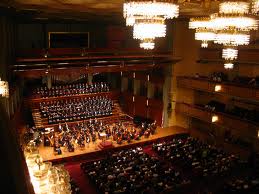
Copyright 2014 Vic Socotra
www.vicsocotra.com
Twitter: @jayare303
Nick’s Number One
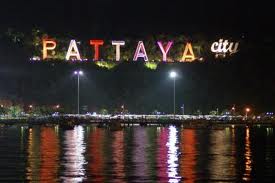
It was summer in 1979. I had a list of things to do when I got to Bangkok, and a couple things to keep a weather eye on.
I made the first liberty boat- local hire, painted pastel pink and watched the sliver of the new moon rising above the sunset as the gigantic gray steel flank of the ship slipped away. The Thai boatman’s apprentice sold us cold Amarit beers at exorbitant prices. Halfway in, the smell of JP-5 jet fuel that permeated the big ship changed to a rich mixture of spice and wet soil, the interface between the land and the sea.
We rammed the beach and I swung over the gunwale and into the surf up to my knees and waded up to the beach. Past the tee-shirt sellers, the Thai-stick hustlers, the beggers and the USS Midway Wive’s Club, across the beach road with the gaudy jeepneys, and onto a stool at an open-air cocktail lounge. One beer later I was in the back of an air-conditioned VW micro-bus and on the high-road to Bangkok.
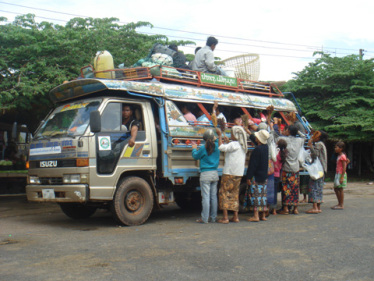
The traffic was crazy. The automobile is a recent innovation for the Thais, and since they believe in reincarnation, traffic fatalities are cheerfully accepted. We saw our first corpse on the road in twenty minutes. Travelers on the road up to the capital the next day saw nineteen, the result of a crash on one of the ubiquitous buses. It is part of the whole experience, you know?
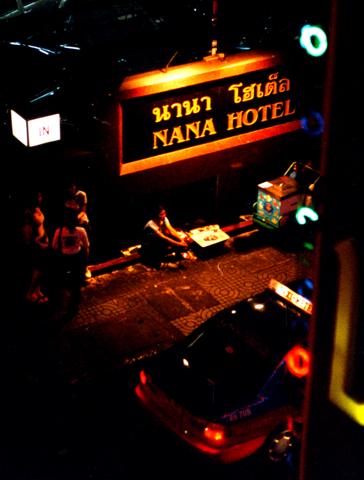
We arrived at the turn onto Sukumvit Road presently and headed into the city proper. At Soi 4 I was dropped at the Nana Hotel where I had made reservations.
“Sleep With Me!” it said on the Nana’s T-shirts. I dumped my stuff in the airy room and made preparations to go out. I flagged an open pedicab down on the street and climbed in, saying: “Patpong Road, driver, and step on me.”
I was down in the legendary bar district, by ten-thirty. The Flying Machine Bar was the most interesting, and had many signed photos of Western celebrities who had relaxed there, including Greg Morris of the Mission Impossible television show. It seemed completely appropriate. The bustle was amazing as hustlers worked the crowd. There were expat Yanks and Aussies, Germans and perhaps a few Icelanders. The hustlers were a blend of Thais, and Khmers, Lao and Malay. They were very attractive, the girls and the ones who certainly looked like girls, and the cab rides were cheap.
We dined that night at the Famous Nick’s Number One Hungarian Inn, located in a huge musty old palace festooned with the business cards of thousands of patrons on the walls. There was a 1978 University of Michigan football schedule on the wall. They say the place is haunted, and I was prepared to believe it.
I chanced to meet Nick himself over a plate of marvelous Kobe beef I could never have afforded back in Japan. He was a thick-set suave Hungarian of a certain age with a story. He had been a prisoner of the Japanese as a young man, later an entrepreneur extraordinaire, and currently a Thai national.
“Try the Kobe Steak al la Nick,” he said. “It is the least objectionable thing on the menu.” The smoke of this Dunhill curled over his fingers as he sipped a martini. He was the master of the innuendo.
We dined with him several nights as my shipmates cycled through the city from Pattaya Beach.
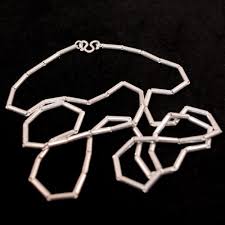
We haggled for gold in Chinatown, bought tribal silver fashioned as baht chains and reclined in the heat of the day by the Nana’s pool that was as tepid as a bath. Late at night, after the real bars closed down, we discovered something that was quite extraordinary: the coffee shop at the Grace Hotel.
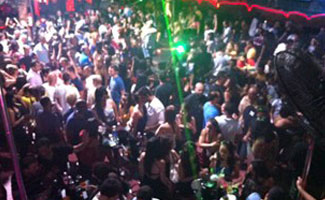
As a restaurant, the ‘coffee shop’ stayed open when the rest of the bars started to close down. Everyone who had not found something better to do- or someone to be with- washed up there. Thais, Khmers, Lao, Chinese, Malay, Burmese, even some Hmong tribal folks, not to mention a few pale slavs. The cantina scene in Star Wars had nothing on the Grace.
When it was finally the night before the ship was going to pull out, I stopped by Nick’s and invited him to tour the aircraft carrier. He graciously accepted, and offered to meet me the next morning and give me a ride down to the Fleet Landing in Pattaya.
Saying farewell to my latest best friend, went down to the lobby, paid my tab and took a cab from the hotel down to the major road junction at Sukumvit Road, noting that the cheap cabs had been transformed by the brief American presence into major expenses. My supply of red-hued bhat currency was running low, though a few of the bills that were in my pocket that day are in an envelope in my bureau.
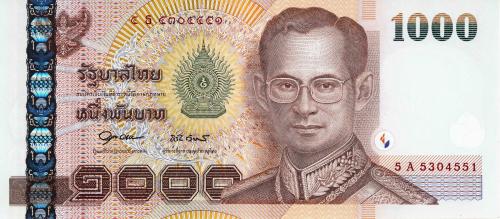
The next time I would need them I was carrying a black diplomatic passport and in a hurry.
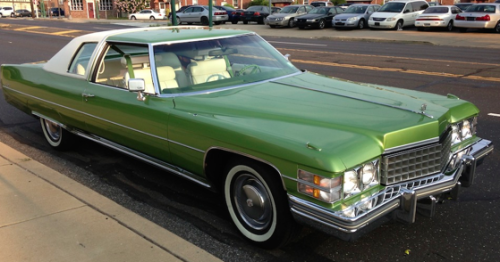
Thus, on the morning of my last day in Thailand, I found my self ensconced on the leather bench seat of the largest lime-green Cadillac in Southeast Asia, riding down to Pattaya in luxury, looking out and accepting the stares of the locals. Nick had his wife in the front right seat and drove with the same cool nonchalance he displayed as a restaurateur.
She fumbled in her purse for more Dunhills when Nick called for them, lighting them from a silver Dunhill lighter. She was a lovely woman, thick black hair curling below her shoulders, and thickening just slightly with maturity. She seemed to care for him deeply, though with the hint of irony that a long marriage brings.
As he drove, he spun tales of what it had been like to be there when the Japanese came, and how his status as a Hungarian “Ally” of the Empire of the Rising Sun had been useful. He said he had been able to help some British and American prisoners, and some commercial internees. That is what got him in trouble, and why the Japanese detained him, too, “Ally” or not.
He complained about the taxes and corruption that doubled the cost of this fine automobile. He talked about the real cowboys that came in 1946 when the city was made of mud the color of the river, flying in war-surplus C-47 transports.
Those were the days, he said wistfully. That was when he started reporting to the Hungarian Intelligence Service through their Embassy. He was a useful asset to them. The war began to heat up next door and Bangkok became the Rest and Recreation destination of choice for thousands of Americans taking a mid-tour break from the horror.
They drank and they talked loudly at Nick’s bar, and after he finished pouring the drinks and the soldiers tool cabs to the Grace Hotel he would write up his notes and pass them to his handler at the Embassy.
It was a pleasant and painless way to supplement his income, and doubtless the intelligence on the American disposition in the War next door helped to pay the taxes on the car in which I was riding.
He parked the car near the Fleet Landing and he and his wife enjoyed a tour of the ship. I suspected that he was listening for intelligence on our capabilities and next port of call. I figured it was the least we could do for him. Intelligence after the end of the Southeast Asia war was pretty thin for him, and he was getting on in years.
I figured it was about the least I could do in exchange for the ride home.
Copyright 2014 Vic Socotra
www.vicsocotra.com
Twitter: @jayare303
Motivated
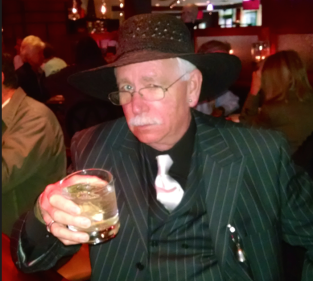
I don’t have it this morning, sorry. I was going to thrill you with a bag-dragging tale about Shanghai in 1997, but I can’t find the pictures that I had digitized years ago. If I get to it I will bore you with an integrated presentation It was a semi-busy week, a lot of thoughts about old rambling days and great cities and hotels around the world, and particularly Asia, where my thoughts are draw to where my son is assigned these days. I remember those days so vividly, and the days since have blown away like the organ leaves on the maple tree outside the dining room window of the apartment I rent in Arlington. So many things not quite as I expected them to be.
I had a chance to re-hash some of the old days with my pal from Chesapeake, who is in town on official business. We had lunch at Willow- he enjoyed the award-winning double-smoke burger paired with Tracy’s remarkable Tater Tots. I went with the Friday Lunch Counter Special, a small cup of black bean soup and a half Cuban pressed sandwich and a couple glasses of the Happy Hour White, which it wasn’t, per se, being only noon, but the hell with it.
By the time we had solved most of the world’s problems, it was getting on to time for a nap, so I wandered home, passing the entire complement of the Barrett Elementary School strung out in costume, headed for the assisted living facility at Culpeper Gardens. The old folks view the arrival of the kids as second only to election day for excitement.
I felt my motivation for the project I was supposed to be doing ebb. I tried the nap, and managed to get between the worlds briefly until someone knocked on the door. I was a little bleary, and looked out as I opened the door to see a ghostly figure in a white cape, stark white makeup, Elsa Lancaster Bride of Frankenstien shock of white hair and right red lips blood-like on the stark white visage.
I blanched myself, momentary, and recognized it was Ann, who works the concierge desk when Rhonda wants to take a day off. She handed me a container of some sort of meat and rice, and I thanked her, kissing her hand, since I didn’t want to mar her makeup.
She looked truly creepy. Great costume.
She had children to scare somewhere and bade me adieu as I closed the door and kicked myself for not thinking through the whole costume thing. I looked at the clock and realized I had to do something, so I reprised the Mac the Knife soot-suit from last year. I have been growing a mustache in honor of Men’s Health Month as part of a challenge from a pal who wears a fierce van dyke goatee with a wild stash that he grew last year and decided to keep.
The line I have been using is: “I march for breast cancer awareness, grow a mustache to promote prostate cancer awareness, and forget what I do about Alzheimer’s.”
I pulled on the suit over a black shirt and pearl tie, grabbed the black hat a friend keeps here in case she wants to attend the Gold Cup in the Spring, and slung a dagger on the silver-chased black belt and went back to Willow.
In addition to Halloween, it was Buffalo Night, so the usual suspects were all there- Long Hair Mike, Jerry the Barrister, Jon-without, Shy Peter, and a pretty good crowd of civilians. Old Jim was not present. We think he might be in Las Vegas on a mission, and are anxious to see how he is doing. Sabrina and Brett, supported by Sammy and Jasper were working the bar, and it was a lively evening, though it was not going to be a late night, for me, anyway. with those amazing locally raised, humanely treated, slow-cooked and thinly-sliced steamer rounds of beef piled high on Kate’s fresh-baked Kemmelweck rolls crusted with sea-salt and fennel.
It was a pleasant enough evening. I took off and went home a little after seven, and was in bed by eight-thirty. I dunno what it is these days. I just can’t seem to get motivated, but the sleeping seems good enough. Maybe after the election things will get back to normal, whatever that is.
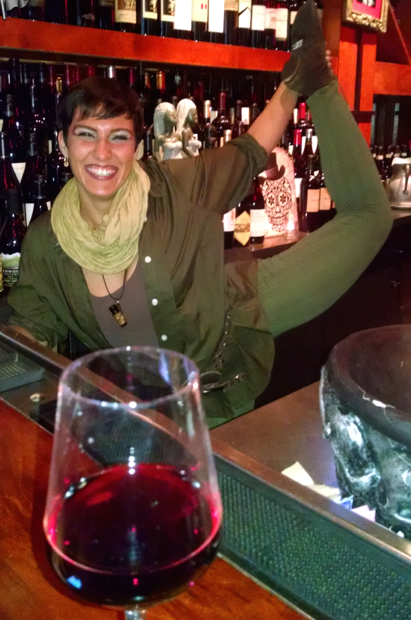
(Sabrina as Peter Pan. Pleasant evening. Still not motivated. Sabrina is a yoga instructor and remarkably lithe. I am thinking about taking it up).
Copyright 2014 Vic Socotra
www.vicsocotra.com <http://www.vicsocotra.com>
Twitter: @jayare303
